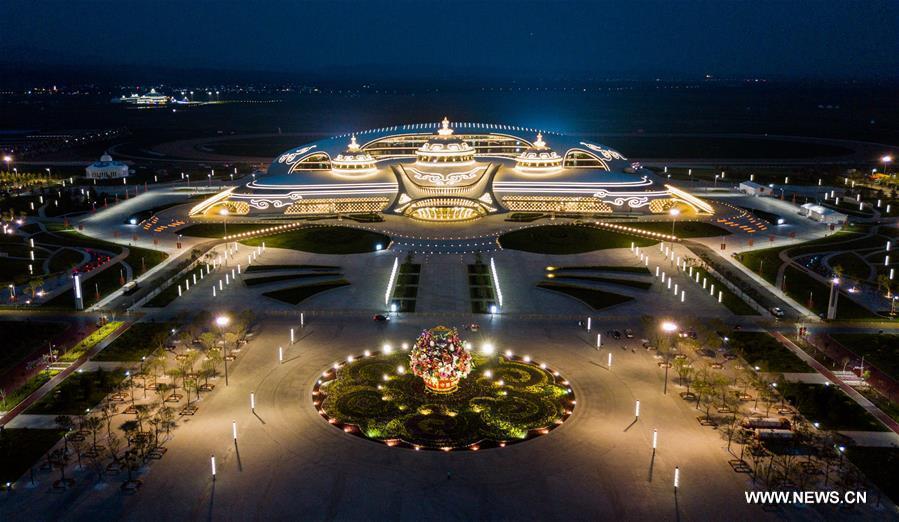Inner Mongolia celebrates 70 years as autonomous region
Xinhua2017-08-06 12:47

Photo taken on Aug. 1, 2017 shows the Inner Mongolia Ethnic Minorities Cultural Sports Center in Hohhot, capital of north China's Inner Mongolia Autonomous Region. This group of photos taken by drones shows landmarks of the city, reflecting the development of the city in recent years. This year marks the 70th anniversary of the founding of the Inner Mongolia Autonomous Region. In local language, Hohhot means the "Blue City". It is the political, economic and cultural center of the region. (Xinhua/Lian Zhen)
BEIJING, Aug. 5 (Xinhua) -- The Inner Mongolia Autonomous Region, home to a mix of ethnic minorities, has made great progress in various respects over the past 70 years.
Seventy years ago, China's first autonomous region governed by the ethnic groups was established in Inner Mongolia.
"The place has physically transformed in the last half a century," said Kerry Brown, one of Britain's leading experts on China, who did his Ph.D. on Inner Mongolia.
He is joined by another Russia-based expert, Andrey Ostrovsky, who said, "Inner Mongolia is one of the leading regions in terms of economic growth, as well as GDP(gross domestic product) per capita." The deputy director of the Institute of Far Eastern Studies at the Russian Academy of Sciences has been to Inner Mongolia many times.
ECONOMIC PROGRESS
Last year, Inner Mongolia's GDP increased by 7.2 percent year-on-year while per capita GDP was up by 6.9 percent.
Ostrovsky thought China's program for the development of the western regions, which was adopted in 2000, benefited Inner Mongolia the most.
"It received the maximum of investments and used the natural resources discovered there for the benefit of the development of the Inner Mongolia Autonomous Region," said Ostrovsky.
Meanwhile, Brown believed Inner Mongolia is among one of the fastest developing areas after China further opened up to enter the World Trade Organization in 2001.
Today, Inner Mongolia is opening itself up to the world with more vitality, and the Belt and Road Initiative is also benefitting Inner Mongolia.
The China-Europe Railway Express runs through Inner Mongolia, connecting China with Europe, and the China-Mongolia Expo is also held here.
ECOLOGICAL SUSTAINABILITY
As a Chinese ballad goes, "under boundless sky, on vast prairies, herds of cows and sheep emerge when the wind blows and grass lowers," which is descriptive of the landscape in Inner Mongolia.
However, at the end of the last century, over-grazing, expanding farms and population pressure, coupled with drought and other natural disasters, led to the desertification of many parts of Inner Mongolia.
Ostrovsky said the main environmental issue in Inner Mongolia is loess, which pollutes the air and the Yellow River.
He regarded it as one of the most serious problems, not only for Inner Mongolia, but also for China as a whole.
Nowadays, various measures, such as reforestation and restricting grazing areas, are stopping the land degradation.
Inner Mongolia has thus embarked on a road of balanced development between economy and environment, claiming a double victory over desertification and poverty.`
EDUCATIONAL ACHIEVEMENTS
Mongolian language education is an essential part of the education system in this autonomous region since the language is inseparable from the culture.
"The language is preserved, the citizens speak Mongolian," Ostrovsky said.
According to the local government, almost every Mongolian preschooler can enjoy a Chinese-Mongolian bilingual education.
He told Xinhua that he has just received a document from Inner Mongolia, which was written in two languages, Mongolian and Chinese.
"You need knowledge of the Mongolian language to work in Inner Mongolia," said Ostrovsky.
Ostrovsky also mentioned the education system for ethnic minorities which is being encouraged in China: They receive their education in large cities, after which they return to their hometowns to help them develop and flourish.
Such a system offers children of ethnic minorities a higher quality of education and an opportunity to gain valuable experiences outside of their native regions.
